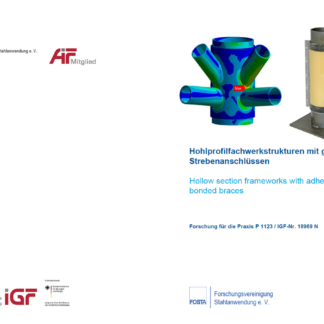Description
P 1123 – Hollow section frameworks with adhesively bonded braces
Foundation structures of offshore wind turbines for water depths of more than 20 m are often designed as jacket framework structures. Up to now, the individual hollow sections of these truss constructions have been joined by welding. Due to the spatial intersection of the tubular profiles at the junctions and the resulting complex weld seam geometries as well as the large open areas required for final assembly, this represents a major production effort. An innovative hybrid connection of the bracings to the legs of these supporting structures is the focus of this research project. The concept combines the joining processes of adhesive bonding, welding and screwing by the formation of node shells at the ends of the bracings. These individual partial shells are designed in such a way that they enclose the corner post and are supplemented to form a complete shell during assembly. After screwing the individual partial shells to a tubular ring, the remaining gap between the node ring shell and the leg tube wall is adhesively bonded. This work step takes place in the manufacturing plant and thus under defined environmental conditions. This construction has the advantage that permanently acting static loads (such as dead weight) are almost completely dissipated through the corner posts. Furthermore, a local fatigue strength results due to the lack of weld connections on the leg components. In addition, the construction method enables prefabrication of the bracings and the modular design of the jacket.
First, the requirements and boundary conditions of the jacket support structure are analyzed and defined. In close cooperation with companies in the offshore wind energy sector, the stresses from wind, wave impact and turbine operation are analysed. Real climate data measured on research platforms in the North Sea are also be evaluated and requirements derived for the bonded joint. Due to the dimensional tolerances of the parts to be joined, thick-film adhesives of up to 25 mm are required. Extensive numerical investigations are used to analyse the stress on the bonded joint and the steel structure. Numerical models of the entire jacket support structure are created for this purpose. A global framework model is combined with volume models in the area of the bonded connections in order to determine the local stress of the bond. It is shown that due to the constructive design of the connections, both highly rigid and elastic adhesives can be used. Based on the developed boundary conditions and requirements, suitable commercially available 2-component adhesives are selected in the next step. These will be characterized experimentally. Based on the results, two adhesives will be prioritized: a highly rigid 2-component polyurethane adhesive and an elastic 2-component adhesive based on EP-PU hybrid.
Published in:
January 2021
Authors:
Dr.-Ing. M. Albiez, J. Damm, M.Sc., Prof. Dr.-Ing. T. Ummenhofer, Dipl.-Wirt.-Ing. S. Myslicki, Dr. T. Vallée, H. Ehard, M. Eng., Prof. Dr.-Ing. Ch. Schuler




